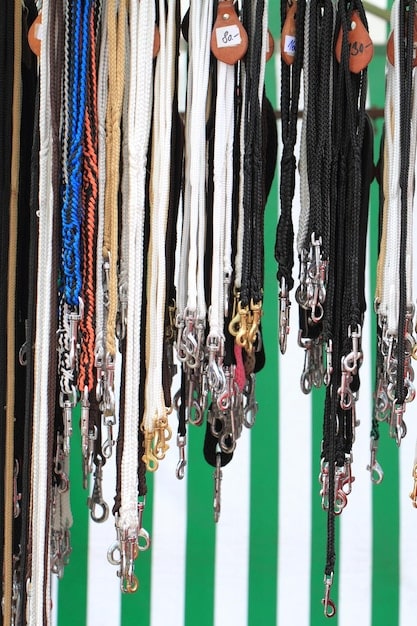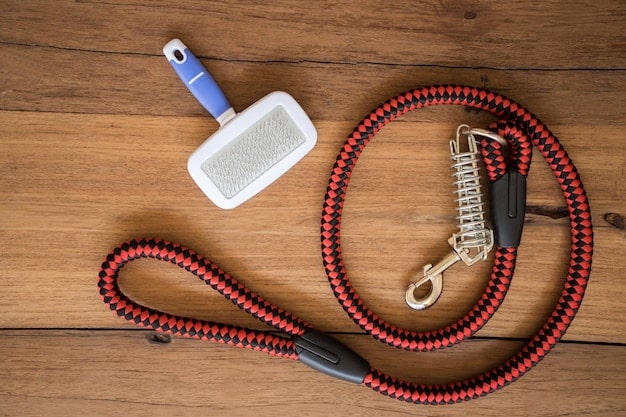The Ultimate Guide to Dog Leashes: Reviews & Safety Tips

Choosing the right dog leash involves considering factors like leash type, material, length, and hardware to ensure safety and control during walks and training, while also catering to your dog’s specific needs and temperament.
Walking your dog is a joy, but ensuring their safety and comfort is paramount. This the ultimate guide to choosing the right dog leash: product reviews and safety tips will help you navigate the options and make the best choice for you and your furry friend.
Understanding the Basics of Dog Leashes
Before diving into product reviews, it’s essential to understand the basic components and types of dog leashes. This knowledge will help you make an informed decision when selecting the right leash for your dog.
Essential Components of a Dog Leash
A dog leash usually consists of a few core elements. Knowing these parts will help you assess the quality and suitability of different leashes.
- Leash Material: Leashes are commonly made from nylon, leather, rope, or chain.
- Hardware: This includes the clasp that attaches to the collar or harness, as well as any rings or buckles for adjusting length or adding accessories.
- Handle: The handle should be comfortable to hold and provide a secure grip.
Different Types of Dog Leashes
The market offers a variety of leashes, each designed for specific purposes. Here are some common types:
- Standard Leash: Typically 4 to 8 feet long, ideal for everyday walking and training.
- Retractable Leash: Extends to varying lengths, giving your dog more freedom to roam but less control for you.
- Training Leash: Longer than standard leashes, used for recall training and off-leash simulations.
- Double Dog Leash: Allows you to walk two dogs at once, minimizing tangled leashes.

When choosing a dog leash, consider your dog’s size, breed, and temperament, as well as the environment where you’ll be walking. A sturdy, well-made leash that suits your needs will make walks safer and more enjoyable.
Factors to Consider When Choosing a Dog Leash
Choosing the right dog leash depends on several factors, including your dog’s size, breed, temperament, and your specific needs. Evaluating these aspects will ensure you select a leash that provides safety, control, and comfort for both you and your pet.
Dog Size and Breed
The size and breed of your dog play a significant role in determining the appropriate leash. Larger, stronger dogs require more durable leashes and secure hardware.
- Small Breeds: Lightweight nylon or rope leashes are suitable for small breeds like Chihuahuas or Pomeranians.
- Medium Breeds: Opt for sturdy nylon or leather leashes for medium-sized dogs such as Beagles or Cocker Spaniels.
- Large Breeds: Heavy-duty nylon, leather, or even chain leashes are necessary for large breeds like German Shepherds or Labrador Retrievers.
Dog Temperament and Training Level
A dog’s temperament and training level also influence the type of leash you should choose. Energetic or untrained dogs may require different leashes compared to well-behaved ones.
- Energetic Dogs: A shorter leash (4 feet) can provide better control over energetic dogs that tend to pull.
- Well-Trained Dogs: A longer leash (6-8 feet) may be suitable for well-trained dogs that walk nicely on a leash.
- Dogs in Training: Training leashes or long lines are helpful for recall exercises and teaching off-leash behavior.
Leash Material and Durability
The material of the leash affects its durability, comfort, and suitability for different weather conditions. Consider these common materials:
- Nylon: Strong, weather-resistant, and easy to clean, making it a popular choice for everyday use.
- Leather: Durable and becomes more comfortable over time, but requires regular maintenance and is not ideal for wet conditions.
- Rope: Lightweight and comfortable to hold, but may not be as durable as nylon or leather for strong pullers.
By carefully considering your dog’s size, temperament, and the leash material, you can select a leash that offers the best combination of safety, control, and comfort. This tailored approach will enhance your walking experiences and ensure your dog’s well-being.
Top Dog Leash Product Reviews
Choosing the right dog leash can be overwhelming, given the multitude of options available. In this section, we review some of the top-rated dog leashes, highlighting their features, pros, and cons to help you make an informed decision.
Best Overall: The Ruffwear Knot-a-Leash
The Ruffwear Knot-a-Leash is a durable, rope-style leash that’s perfect for everyday walks and outdoor adventures.
- Material: Strong, supple rope
- Length: 5 feet
- Pros: Comfortable grip, secure locking carabiner, reflective trim
- Cons: Can be bulky for small dogs
Best Retractable Leash: The Flexi Vario
The Flexi Vario offers smooth retraction and customizable features, making it a favorite among retractable leash users.
- Material: Durable plastic casing with a nylon tape leash
- Length: Extends up to 26 feet
- Pros: Customizable handle and accessories, reliable braking system, comfortable grip
- Cons: Can be heavy, requires careful handling
Best for Training: The Leatherberg Leather Dog Leash
The Leatherberg Leather Dog Leash is a high-quality leather leash that provides excellent control and durability for training purposes.
- Material: Premium leather
- Length: 6 feet
- Pros: Comfortable grip, durable construction, classic look
- Cons: Requires regular maintenance, more expensive than nylon leashes

Best for Two Dogs: The PetSafe Dual Dog Leash Coupler
The PetSafe Dual Dog Leash Coupler is designed to walk two dogs at once, preventing tangles and providing a comfortable experience.
- Material: Durable nylon
- Length: Adjustable
- Pros: Tangle-free swivel design, adjustable length, comfortable handle
- Cons: May not be suitable for dogs with significant size differences
These product reviews offer a glimpse into some of the best dog leashes available. Consider your specific needs and preferences when making your final decision. A well-chosen leash can significantly enhance your dog walking experience.
Safety Tips for Using Dog Leashes
Using a dog leash safely is crucial for preventing accidents and ensuring the well-being of your dog. This section provides essential safety tips to help you handle your dog leash responsibly.
Proper Leash Handling Techniques
Mastering proper leash handling techniques can prevent injuries to both you and your dog. Here are some key tips:
- Avoid Wrapping the Leash Around Your Hand: This can lead to serious injuries if your dog suddenly pulls.
- Keep the Leash Loose: A tight leash can communicate anxiety to your dog and encourage pulling.
- Use a Short Leash in Crowded Areas: This provides better control and prevents your dog from wandering into traffic or disturbing others.
Preventing Leash-Related Injuries
Leash-related injuries can occur if proper precautions are not taken. Be mindful of these potential hazards:
- Choking Hazards: Ensure the collar or harness fits properly and does not tighten excessively.
- Entanglement: Be cautious of trees, poles, and other obstacles that can cause the leash to become tangled.
- Sudden Jerks: Avoid sudden, forceful jerks that can strain your dog’s neck or back.
Choosing the Right Collar or Harness
The choice between a collar and a harness can impact your dog’s safety and comfort. Consider these factors:
- Collars: Suitable for dogs that walk nicely on a leash and have no respiratory issues.
- Harnesses: Recommended for dogs that pull, have breathing problems, or are prone to neck injuries.
By following these safety tips, you can minimize the risk of accidents and ensure that your dog walking experience is both safe and enjoyable. Responsible leash handling is a key component of pet ownership.
Leash Training Tips for Puppies and Adult Dogs
Leash training is a fundamental aspect of dog ownership, essential for both puppies and adult dogs. Effective training techniques can make walks more enjoyable and safer for everyone involved.
Getting Started with Leash Training for Puppies
Introducing puppies to the leash at a young age can help them develop positive associations with it. Follow these steps:
- Introduce the Collar or Harness: Let your puppy wear the collar or harness for short periods, gradually increasing the duration.
- Attach the Leash: Once your puppy is comfortable with the collar or harness, attach the leash and allow them to drag it around.
- Positive Reinforcement: Use treats and praise to reward your puppy for walking calmly on the leash.
Effective Leash Training Techniques for Adult Dogs
Leash training adult dogs, especially those with a history of pulling or anxiety, requires patience and consistency. Consider these techniques:
- Use Positive Reinforcement: Reward your dog for walking beside you with treats, praise, or a favorite toy.
- Change Direction: If your dog starts to pull, change direction to redirect their attention.
- Stop and Wait: If your dog pulls, stop walking and wait until they come back to your side before continuing.
Addressing Common Leash Training Issues
Several common issues can arise during leash training. Here’s how to address them:
- Pulling: Use a front-clip harness or a head halter to discourage pulling.
- Anxiety: Create a positive association with the leash by pairing it with enjoyable activities.
- Aggression: Consult a professional trainer or behaviorist to address aggressive behavior on the leash.
With consistent effort and positive reinforcement, you can successfully leash train your dog, making walks a pleasant experience for both of you. Remember to be patient and adapt your approach to suit your dog’s individual needs.
Choosing Leashes Based on Specific Activities
The right type of dog leash can vary depending on the activity you plan to engage in with your dog. Whether it’s for daily walks, running, or hiking, selecting a leash designed for that specific activity can enhance safety and enjoyment.
Best Leashes for Daily Walks
For everyday walks, a standard leash that provides a balance of control and freedom is ideal. Here are some popular choices:
- Standard Nylon Leash: Durable and versatile for casual walks.
- Leather Leash: Offers a comfortable grip and classic look.
- Rope Leash: Lightweight and easy to handle.
Ideal Leashes for Running and Jogging
When running or jogging with your dog, a hands-free leash or a specialized running leash can provide convenience and prevent injuries.
- Hands-Free Leash: Worn around your waist, allowing you to run without holding the leash.
- Bungee Leash: Absorbs shock and reduces strain on both you and your dog.
Suitable Leashes for Hiking and Outdoor Adventures
For hiking and outdoor adventures, a durable and adjustable leash is essential. Consider these options:
- Long Training Leash: Allows your dog to explore while still maintaining control.
- Retractable Leash (with Caution): Provides freedom but requires careful monitoring.
- Heavy-Duty Nylon Leash: Withstands rough terrain and provides a secure connection.
Selecting the right leash for specific activities can significantly improve the experience for both you and your dog. Ensure the leash is appropriate for the environment and provides the necessary safety and control.
| Key Point | Brief Description |
|---|---|
| 🐕 Leash Type | Choose the leash type based on your dog’s size, temperament, and activity. |
| 🦮 Material | Consider materials like nylon, leather, or rope for durability and comfort. |
| 🐾 Safety | Always prioritize safety by using proper leash handling techniques and avoiding hazards. |
| 🦴 Training | Employ positive reinforcement and consistent techniques for effective leash training. |
Frequently Asked Questions (FAQs)
▼
A 6-foot leash is generally considered the best length for everyday walking. It provides a good balance between control and freedom, allowing your dog to explore while still keeping them close.
▼
Retractable leashes can be safe if used properly. However, they require careful handling and awareness to avoid tangles and sudden pulls. It’s essential to use them responsibly in open areas.
▼
To stop your dog from pulling, use positive reinforcement techniques such as rewarding them for walking beside you. Changing direction and stopping until they return to your side can also be effective.
▼
A collar fits around the dog’s neck and is suitable for well-behaved dogs. A harness wraps around the dog’s body, providing better control and reducing strain on the neck, making it ideal for pullers.
▼
You should replace your dog leash as soon as you notice signs of wear and tear, such as fraying, tears, or weakened hardware. Regularly inspect your leash to ensure it remains in good condition.
Conclusion
Choosing the right dog leash is a critical decision that impacts both your and your dog’s safety and enjoyment during walks. By considering factors such as leash type, material, length, and hardware, you can make an informed choice that caters to your dog’s specific needs and temperament. Remember to prioritize safety by using proper leash handling techniques and addressing any training issues that may arise, ensuring a pleasant and secure experience for both you and your furry companion.





